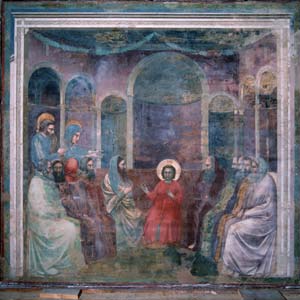 |
| One of the two "lifted"
sections |
 |
Detached portions
Those parts of the frescoes (paint film and plaster)
which were removed from the walls for conservation purposes
during the 19th and 20th centuries, and subsequently replaced
in their original positions, using different techniques and
materials for the new mounting.
Deliberate detachment of parts of the plaster and re-adhesion
directly onto the masonry structure (in other words, without
placing a new rigid support between the plaster and the wall)
were carried out in the 19th century to deal with problems
of adhesion in the preparatory layers where the presence of
marked unevenness of the plaster made it impossible to use
the traditional system of consolidation via mechanical means
(see nails/clamps).
The procedure consisted of carefully marking out the part
to be detached, previously protected with several layers of
very fine canvas moistened with starch glue; then using a
very sharp steel blade, cutting around and under the plaster
and removing it; once removed, the uneven plaster was smoothed
out and consolidated from behind, then cut back to a thickness
of a few millimetres (about 3 mm); then a new "arriccio"
was made with hydraulic lime to replace the old one, after
having treated the masonry surface with waterproofing substances;
the final step was to re-attach the plaster to the wall using
an adhesive compound ("cemento"), devised by the
restorer Botti, and made of casein, quicklime and crushed
bricks.
|












